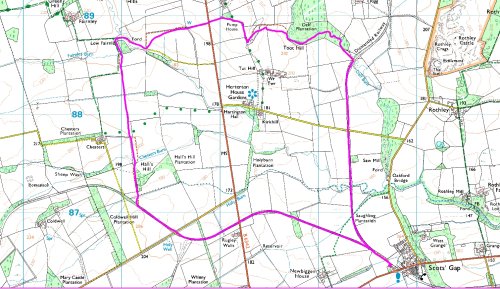April

Route
| Walk leader | Michelle |
|||
| Route | Starting from Scot’s Gap following the old railway line towards Rothbury, then turning onto the Wannie line (from Reedsmouth) for the return leg. Note - the original ten-mile walk planned took a slightly different route. However, because of the freezing cold wind we opted to do the shorter version, using permissive paths on the railway lines. |
|||
| Weather | Not recorded. |
|||
| Walkers | Michelle, Michael, Ron, Sandy, Ashley. |
|||
| Excuses | Ken - exhausted from too much walking through the week Bernie - family matters Diane and Richard - possibly in North Wales George - recovering from skiing injury - although he did his own 6 mile walk on the day. |
|||
Comments |
|
It should be noted that before the walk Ashley twice attempted to drive under the influence of a cup of tea, and managed to move to two different parking spots without spilling a drop! We parked at the rear of some well-kept old buildings, which were apparently at some point in the past the Regional HQ of the National Trust. Of particular note was Ron’s encyclopaedic knowledge of historic Northumberland railways. The Rothbury line opened on 1st November 1870 (the driving force was Sir Walter Trevelyan, owner of Wallington). The passenger service was withdrawn from 15 September 1952. We passed the site of a tragic accident in 1875, when the train derailed and crashed down an embankment killing 4 people and injuring a number of others. We left the Rothbury line as it passed the Delf Burn, where we stopped for a spot of lunch - out of the wind. Leaving the burn, we headed across the fields, where there was an amazing straight ‘hedge’ of full grown Beech trees. Then we descended a rocky outcrop where we found a hidden Geocache. From there we continued down to a quarry with massive, old lime kilns. The quarry was built because there is a strata of very high quality limestone, ideal for burning for use in farming and other industries. When operating, the kiln could be kept running for a year if kept topped up with coal and limestone. They are called ‘burning’ or ‘draw sene’ kilns. After passing through numerous fields full of sheep (never seen so many) with their newborn lambs, we joined the Wannie line for the return. The Wannie line was built in stages and finally reached Reedsmouth on 1 May 1865. Afternoon tea was taken at The Blacksmiths at Belsay - Ashley had the biggest portion of 'Pavlova’ ever - don’t think it touched the sides as it was consumed! Flora & Fauna: |
||
| Meal | ||||
The Blackbird, Ponteland, joined by George and Evelyn. We weren't terribly impressed with the meals, and the portion size was a little on the small side in some cases. Atmosphere - painfully loud. Wouldn’t recommend booking a table in the bar again even if it was the only table available. Repaired to Sandy and Ron's for coffee and the ambience to converse.
|
||||
| Photo Gallery |
Walkers
|
|||
The Wannie Line |
Hart Burn |
Rothley Crags |
Walking the Rothbury Line |
Delf Burn |
Walkers in Delf Plantation
|
Lunch
|
Lone Trees
|
Trees
|
Rothley Castle
|
Passing the slabs
|
Lime Kiln
|
Friendly Lamb
|
Little Poser!
|
Newborns
|
Ruby investigates a Strange Object
|